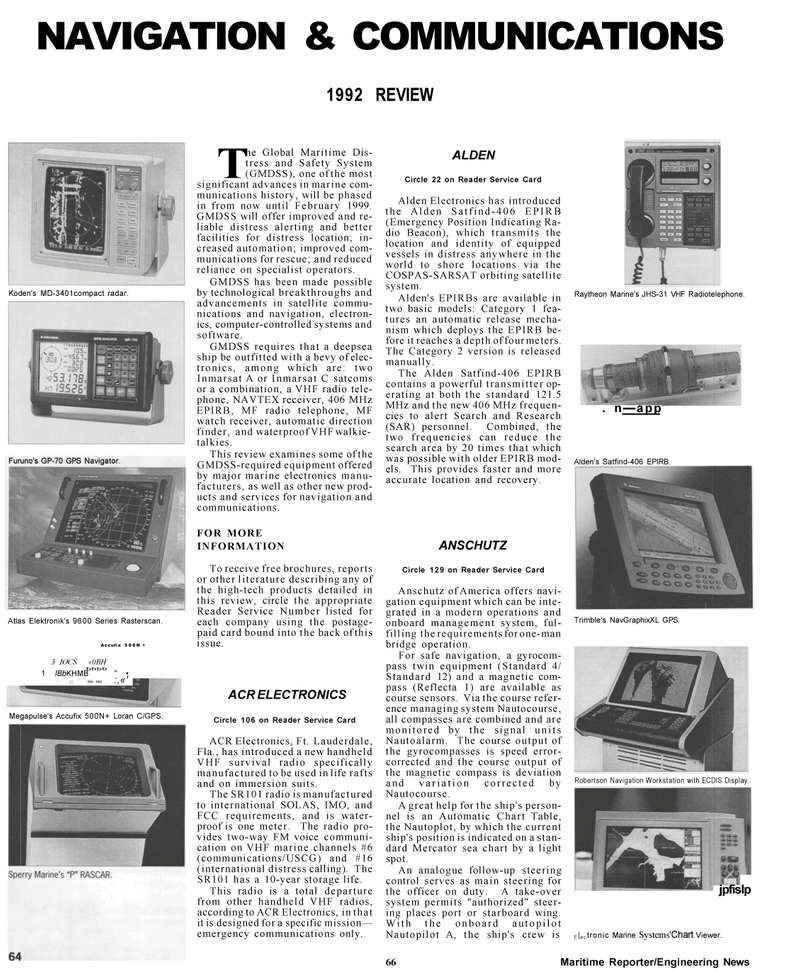
Page 64: of Maritime Reporter Magazine (March 1992)
Read this page in Pdf, Flash or Html5 edition of March 1992 Maritime Reporter Magazine
NAVIGATION & COMMUNICATIONS 1992 REVIEW
Koden's MD-3401compact radar.
Atlas Elektronik's 9600 Series Rasterscan.
Megapulse's Accufix 500N+ Loran C/GPS.
The Global Maritime Dis-tress and Safety System (GMDSS), one of the most significant advances in marine com- munications history, will be phased in from now until February 1999.
GMDSS will offer improved and re- liable distress alerting and better facilities for distress location; in- creased automation; improved com- munications for rescue; and reduced reliance on specialist operators.
GMDSS has been made possible by technological breakthroughs and advancements in satellite commu- nications and navigation, electron- ics, computer-controlled systems and software.
GMDSS requires that a deepsea ship be outfitted with a bevy of elec- tronics, among which are: two
Inmarsat A or Inmarsat C satcoms or a combination, a VHF radio tele- phone, NAVTEX receiver, 406 MHz
EPIRB, MF radio telephone, MF watch receiver, automatic direction finder, and waterproof VHF walkie- talkies.
This review examines some of the
GMDSS-required equipment offered by major marine electronics manu- facturers, as well as other new prod- ucts and services for navigation and communications.
FOR MORE
INFORMATION
To receive free brochures, reports or other literature describing any of the high-tech products detailed in this review, circle the appropriate
Reader Service Number listed for each company using the postage- paid card bound into the back of this issue.
ACR ELECTRONICS
Circle 106 on Reader Service Card
ACR Electronics, Ft. Lauderdale,
Fla., has introduced a new handheld
VHF survival radio specifically manufactured to be used in life rafts and on immersion suits.
The SR101 radio is manufactured to international SOLAS, IMO, and
FCC requirements, and is water- proof is one meter. The radio pro- vides two-way FM voice communi- cation on VHF marine channels #6 (communications/USCG) and #16 (international distress calling). The
SR101 has a 10-year storage life.
This radio is a total departure from other handheld VHF radios, according to ACR Electronics, in that it is designed for a specific mission— emergency communications only.
Accufix 500N + 3 IOCS «0BH ' bhbb 1 IBbKHMB " • - :: mm mm :,«'
ALDEN
Circle 22 on Reader Service Card
Alden Electronics has introduced the Alden Satfind-406 EPIRB (Emergency Position Indicating Ra- dio Beacon), which transmits the location and identity of equipped vessels in distress anywhere in the world to shore locations via the
COSPAS-SARSAT orbiting satellite system.
Alden's EPIRBs are available in two basic models: Category 1 fea- tures an automatic release mecha- nism which deploys the EPIRB be- fore it reaches a depth of four meters.
The Category 2 version is released manually.
The Alden Satfind-406 EPIRB contains a powerful transmitter op- erating at both the standard 121.5
MHz and the new 406 MHz frequen- cies to alert Search and Research (SAR) personnel. Combined, the two frequencies can reduce the search area by 20 times that which was possible with older EPIRB mod- els. This provides faster and more accurate location and recovery.
ANSCHUTZ
Circle 129 on Reader Service Card
Anschutz of America offers navi- gation equipment which can be inte- grated in a modern operations and onboard management system, ful- filling the requirements for one-man bridge operation.
For safe navigation, a gyrocom- pass twin equipment (Standard 4/
Standard 12) and a magnetic com- pass (Reflecta 1) are available as course sensors. Via the course refer- ence managing system Nautocourse, all compasses are combined and are monitored by the signal units
Nautoalarm. The course output of the gyrocompasses is speed error- corrected and the course output of the magnetic compass is deviation and variation corrected by
Nautocourse.
A great help for the ship's person- nel is an Automatic Chart Table, the Nautoplot, by which the current ship's position is indicated on a stan- dard Mercator sea chart by a light spot.
An analogue follow-up steering control serves as main steering for the officer on duty. A take-over system permits "authorized" steer- ing places port or starboard wing.
With the onboard autopilot
Nautopilot A, the ship's crew is E|ectronic Marine Systems'Chart Viewer. 66 Maritime Reporter/Engineering News
Furuno's GP-70 GPS Navigator. . n—app
Raytheon Marine's JHS-31 VHF Radiotelephone.
Alden's Satfind-406 EPIRB.
Trimble's NavGraphixXL GPS.
Robertson Navigation Workstation with ECDIS Display. jpfislp

 63
63

 65
65
